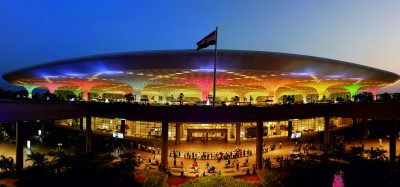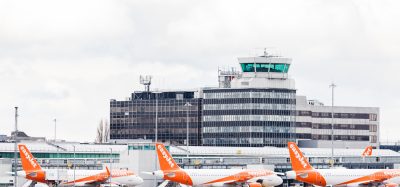First ever round-the-world solar flight successfully completed
- Like
- Digg
- Del
- Tumblr
- VKontakte
- Buffer
- Love This
- Odnoklassniki
- Meneame
- Blogger
- Amazon
- Yahoo Mail
- Gmail
- AOL
- Newsvine
- HackerNews
- Evernote
- MySpace
- Mail.ru
- Viadeo
- Line
- Comments
- Yummly
- SMS
- Viber
- Telegram
- Subscribe
- Skype
- Facebook Messenger
- Kakao
- LiveJournal
- Yammer
- Edgar
- Fintel
- Mix
- Instapaper
- Copy Link
Posted: 26 July 2016 | Katie Sadler, Digital Content Producer, International Airport Review | No comments yet
The first ever round-the-world solar flight has been successfully completed, landing in Abu Dhabi in the United Arab Emirates on 26 July 2016.
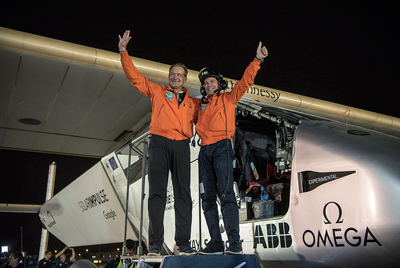

The first ever round-the-world solar flight has been successfully completed, landing in Abu Dhabi in the United Arab Emirates on 26 July 2016.


Solar impulse landing in Abu Dhabi
Swiss pioneers Bertrand Piccard and André Borschberg landed safely after a total of 23 days of flight taking turns at the controls of the unpressurised and unheated Solar Impulse 2 (Si2) – their zero-emission electric and solar airplane. The carbon-fiber Si2, capable of flying day and night without fuel, travelled 43,041km during its 17 leg journey travelling at speeds between 28 mph and 34mph.
Aircraft lands safely after 23 days of solar flight
Piccard and Borschberg have said they will continue to urge the global implementation of energy efficient solutions through the creation of the International Committee for Clean Technologies and leverage the expertise and technology gained over the years in Solar Impulse by launching new innovative projects, such as the development of solar powered drones.
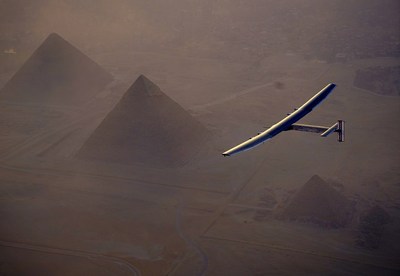

Solar Impulse flying over the pyramids, Egypt
The aircraft embarked on its epic journey on 09 March 2016 from Abu Dhabi. From there it crossed Asia, the Pacific Ocean, the USA, the Atlantic Ocean, the Mediterranean Sea and the Middle East. A total of 19 world records were set or are still pending by the World Air Sports Federation (FAI); in particular when André Borschberg accomplished flying five consecutive days and nights over the Pacific Ocean from Japan to Hawaii – the longest duration a solo airplane of any kind has ever flown.
Round-the-world solar flight: the journey
“This is not only a first in the history of aviation; it’s before all a first in the history of energy”
Commenting on the achievement, Initiator, Chairman and Pilot Bertrand Piccard said “This is not only a first in the history of aviation; it’s before all a first in the history of energy. I’m sure that within 10 years we’ll see electric airplanes transporting 50 passengers on short to medium haul flights. But it’s not enough. The same clean technologies used on Solar Impulse could be implemented on the ground in our daily life to divide by two the CO2 emissions in a profitable way. Solar Impulse is only the beginning, now take it further! ”
|
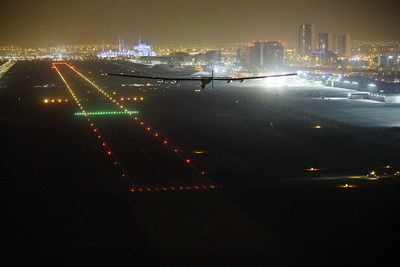

Landing in Abu Dhabi marking the end of the solar flight
“Electric airplanes will develop in the near future because of their tremendous advantages”
Co-Founder and Pilot André Borschberg added, “Flying one leg with a completely new type of airplane is difficult enough, but flying around the world is a real challenge. More than a demonstration, it’s the confirmation that these technologies are truly dependable and reliable. There is so much potential for the aeronautical world: while one hundred percent solar powered airplanes might take longer to materialise, electric airplanes will develop in the near future because of their tremendous advantages such as energy efficiency.”
A few hours before touching down in Abu Dhabi, Bertrand Piccard spoke to UN Secretary-General Ban Ki-moon live from the Si2 cockpit: “Solar Impulse has flown more than 40,000 kilometers without fuel, but with an inexhaustible supply of energy and inspiration. This is a historic day for Captain Piccard and the Solar Impulse team, but it is also a historic day for humanity,” said the UN Secretary-General. “You may be ending your around the world flight today, but the journey to a more sustainable world is just beginning. The Solar Impulse team is helping to pilot us to that future.”





